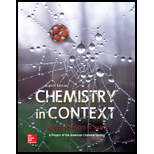
Chemistry in Context
8th Edition
ISBN: 9780073522975
Author: American Chemical Society
Publisher: McGraw-Hill Education
expand_more
expand_more
format_list_bulleted
Concept explainers
Textbook Question
Chapter 10.5, Problem 10.13CT
Modern methods of drug discovery involve systematic studies of compounds with only small variations in structure and computer modeling, among other techniques. Sometimes side effects of a drug may open the door for its usefulness in treating other illnesses. There are many examples where a new drug was discovered by “chance.” Find an example of a drug that was discovered by unusual circumstances and describe its discovery.
Expert Solution & Answer
Want to see the full answer?
Check out a sample textbook solution
Students have asked these similar questions
Use the Henderson-Hasselbalch equation to calculate pH of a buffer containing 0.050M benzoic acidand 0.150M sodium benzoate. The Ka of benzoic acid is 6.5 x 10-5
A. Draw the structure of each of the following alcohols. Then draw and name the product you would expect to produce by the oxidation of each. a. 4-Methyl-2-heptanol
b. 3,4-Dimethyl-1-pentanol
c. 4-Ethyl-2-heptanol
d. 5,7-Dichloro-3-heptanol
What is the pH of a 1.0 L buffer made with 0.300 mol of HF (Ka = 6.8 × 10⁻⁴) and 0.200 mol of NaF to which 0.160 mol of NaOH were added?
Chapter 10 Solutions
Chemistry in Context
Ch. 10.2 - Skill Building Checking on Carbon a. Examine the...Ch. 10.2 - Prob. 10.7YTCh. 10.3 - Skill Building Ester Formation Draw structural...Ch. 10.3 - Prob. 10.10YTCh. 10.4 - Prob. 10.11CTCh. 10.4 - You Decide Supersize My Aspirin A friend who...Ch. 10.5 - Modern methods of drug discovery involve...Ch. 10.5 - Make two lists of drugs for each of the two...Ch. 10.5 - See for yourself the shapes of drug molecules by...Ch. 10.6 - Prob. 10.17YT
Ch. 10.6 - Prob. 10.18CTCh. 10.10 - Prob. 10.24CTCh. 10.10 - Prob. 10.25CTCh. 10.10 - Prob. 10.26YTCh. 10 - Prob. 10.1CTCh. 10 - Prob. 1QCh. 10 - Prob. 2QCh. 10 - Prob. 3QCh. 10 - Write the structural formula and line-angle...Ch. 10 - Prob. 5QCh. 10 - Prob. 6QCh. 10 - Prob. 7QCh. 10 - Prob. 8QCh. 10 - Prob. 9QCh. 10 - Prob. 10QCh. 10 - Prob. 11QCh. 10 - Prob. 12QCh. 10 - Prob. 13QCh. 10 - Prob. 14QCh. 10 - Prob. 15QCh. 10 - Prob. 16QCh. 10 - Prob. 17QCh. 10 - Prob. 18QCh. 10 - Prob. 19QCh. 10 - Prob. 20QCh. 10 - Prob. 21QCh. 10 - Sulfanilamide is the simplest sulfa drug, a type...Ch. 10 - Prob. 23QCh. 10 - Prob. 24QCh. 10 - Prob. 25QCh. 10 - Prob. 26QCh. 10 - Molecules as diverse as cholesterol, sex hormones,...Ch. 10 - The text states that some racemic mixtures contain...Ch. 10 - Draw structural formulas for each of these...Ch. 10 - Prob. 30QCh. 10 - In Your Turn 12.12, you were asked to draw...Ch. 10 - Prob. 32QCh. 10 - Prob. 33QCh. 10 - Prob. 34QCh. 10 - Prob. 35QCh. 10 - Prob. 36QCh. 10 - Prob. 37QCh. 10 - Prob. 38QCh. 10 - Prob. 39QCh. 10 - Prob. 40QCh. 10 - Prob. 41QCh. 10 - Prob. 42QCh. 10 - Dorothy Crowfoot Hodgkin first determined the...Ch. 10 - Prob. 46QCh. 10 - Prob. 47QCh. 10 - Prob. 49QCh. 10 - Prob. 51QCh. 10 - Prob. 52QCh. 10 - Prob. 54QCh. 10 - Prob. 55QCh. 10 - Prob. 56QCh. 10 - Prob. 57QCh. 10 - Prob. 58QCh. 10 - Prob. 59Q
Knowledge Booster
Learn more about
Need a deep-dive on the concept behind this application? Look no further. Learn more about this topic, chemistry and related others by exploring similar questions and additional content below.Similar questions
- Can I please get help with this.arrow_forwardDetermine if the following salt is neutral, acidic or basic. If acidic or basic, write the appropriate equilibrium equation for the acid or base that exists when the salt is dissolved in aqueous solution. If neutral, simply write only NR. Be sure to include the proper phases for all species within the reaction. N₂H₅ClO₄arrow_forwardPlease help me with identifying these.arrow_forward
arrow_back_ios
SEE MORE QUESTIONS
arrow_forward_ios
Recommended textbooks for you

 Chemistry & Chemical ReactivityChemistryISBN:9781337399074Author:John C. Kotz, Paul M. Treichel, John Townsend, David TreichelPublisher:Cengage Learning
Chemistry & Chemical ReactivityChemistryISBN:9781337399074Author:John C. Kotz, Paul M. Treichel, John Townsend, David TreichelPublisher:Cengage Learning Chemistry & Chemical ReactivityChemistryISBN:9781133949640Author:John C. Kotz, Paul M. Treichel, John Townsend, David TreichelPublisher:Cengage Learning
Chemistry & Chemical ReactivityChemistryISBN:9781133949640Author:John C. Kotz, Paul M. Treichel, John Townsend, David TreichelPublisher:Cengage Learning Chemistry: The Molecular ScienceChemistryISBN:9781285199047Author:John W. Moore, Conrad L. StanitskiPublisher:Cengage Learning
Chemistry: The Molecular ScienceChemistryISBN:9781285199047Author:John W. Moore, Conrad L. StanitskiPublisher:Cengage Learning ChemistryChemistryISBN:9781305957404Author:Steven S. Zumdahl, Susan A. Zumdahl, Donald J. DeCostePublisher:Cengage Learning
ChemistryChemistryISBN:9781305957404Author:Steven S. Zumdahl, Susan A. Zumdahl, Donald J. DeCostePublisher:Cengage Learning


Chemistry & Chemical Reactivity
Chemistry
ISBN:9781337399074
Author:John C. Kotz, Paul M. Treichel, John Townsend, David Treichel
Publisher:Cengage Learning

Chemistry & Chemical Reactivity
Chemistry
ISBN:9781133949640
Author:John C. Kotz, Paul M. Treichel, John Townsend, David Treichel
Publisher:Cengage Learning

Chemistry: The Molecular Science
Chemistry
ISBN:9781285199047
Author:John W. Moore, Conrad L. Stanitski
Publisher:Cengage Learning

Chemistry
Chemistry
ISBN:9781305957404
Author:Steven S. Zumdahl, Susan A. Zumdahl, Donald J. DeCoste
Publisher:Cengage Learning

The Creation of Chemistry - The Fundamental Laws: Crash Course Chemistry #3; Author: Crash Course;https://www.youtube.com/watch?v=QiiyvzZBKT8;License: Standard YouTube License, CC-BY